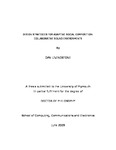Design Strategies for Adaptive Social Composition: Collaborative Sound Environments
| dc.contributor.supervisor | Miranda, Eduardo | |
| dc.contributor.author | Livingstone, Dan | |
| dc.contributor.other | School of Engineering, Computing and Mathematics | en_US |
| dc.date.accessioned | 2013-01-22T12:00:18Z | |
| dc.date.available | 2013-01-22T12:00:18Z | |
| dc.date.issued | 2009 | |
| dc.date.issued | 2009 | |
| dc.identifier | 755040 | en_US |
| dc.identifier.uri | http://hdl.handle.net/10026.1/1252 | |
| dc.description.abstract |
In order to develop successful collaborative music systems a variety of subtle interactions need to be identified and integrated. Gesture capture, motion tracking, real-time synthesis, environmental parameters and ubiquitous technologies can each be effectively used for developing innovative approaches to instrument design, sound installations, interactive music and generative systems. Current solutions tend to prioritise one or more of these approaches, refining a particular interface technology, software design or compositional approach developed for a specific composition, performer or installation environment. Within this diverse field a group of novel controllers, described as ‘Tangible Interfaces’ have been developed. These are intended for use by novices and in many cases follow a simple model of interaction controlling synthesis parameters through simple user actions. Other approaches offer sophisticated compositional frameworks, but many of these are idiosyncratic and highly personalised. As such they are difficult to engage with and ineffective for groups of novices. The objective of this research is to develop effective design strategies for implementing collaborative sound environments using key terms and vocabulary drawn from the available literature. This is articulated by combining an empathic design process with controlled sound perception and interaction experiments. The identified design strategies have been applied to the development of a new collaborative digital instrument. A range of technical and compositional approaches was considered to define this process, which can be described as Adaptive Social Composition. Dan Livingstone | en_US |
| dc.language.iso | en | en_US |
| dc.publisher | University of Plymouth | en_US |
| dc.subject | Co-Creation | |
| dc.subject | Interaction Design | |
| dc.subject | Collaborative Behaviour | |
| dc.subject | Adaptive Music | |
| dc.subject | Novel Interfaces | |
| dc.subject | Computer Music | en_US |
| dc.title | Design Strategies for Adaptive Social Composition: Collaborative Sound Environments | en_US |
| dc.type | Thesis | |
| plymouth.version | Full version | en_US |
| dc.identifier.doi | http://dx.doi.org/10.24382/1471 |
Files in this item
This item appears in the following Collection(s)
-
01 Research Theses Main Collection
Research Theses Main


